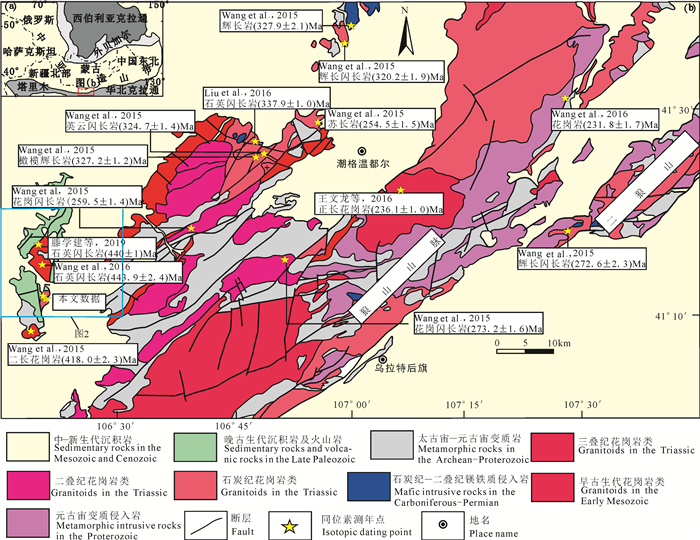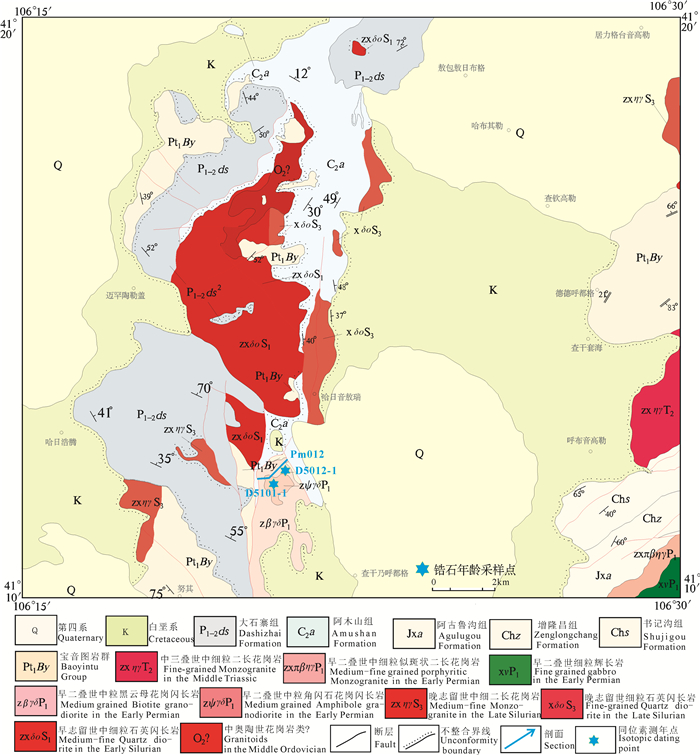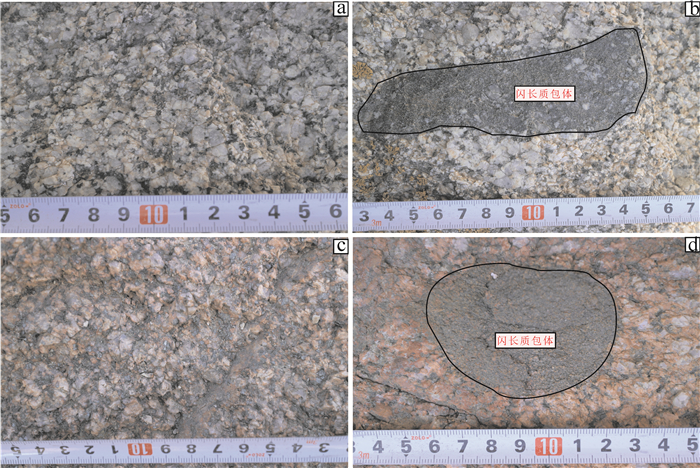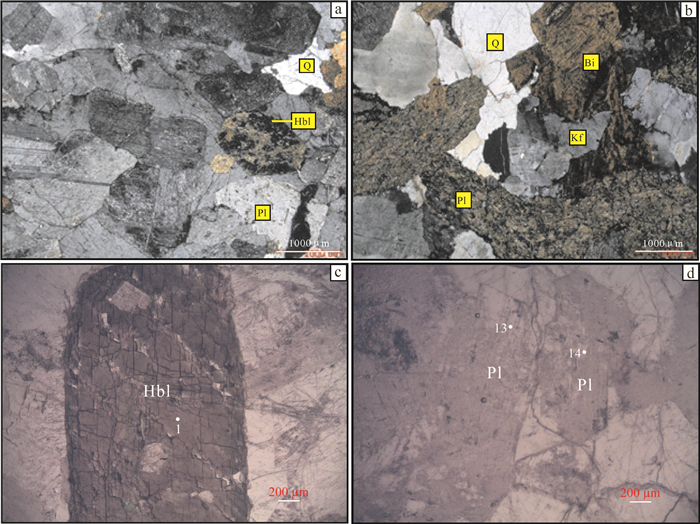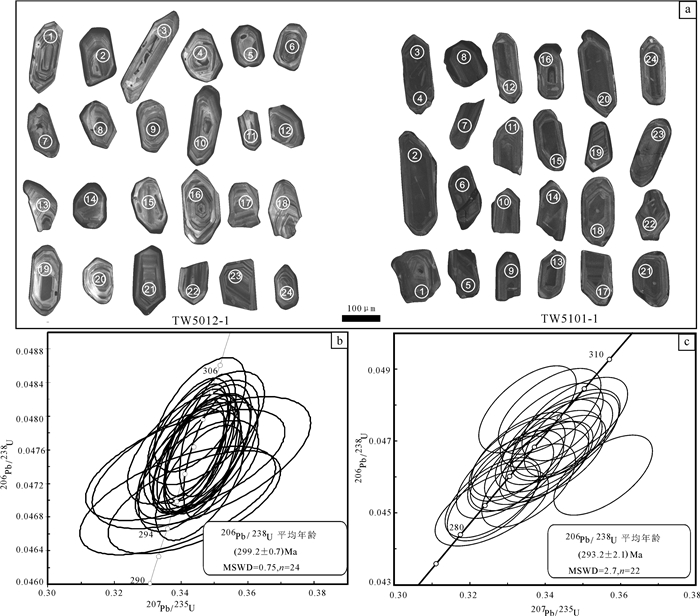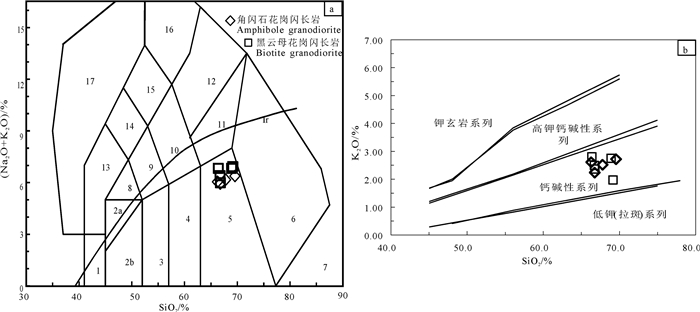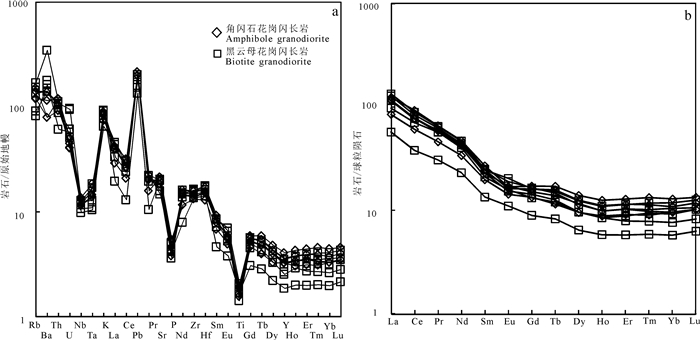The chronology, geochemistry of the Early Permian granodiorite in Langshan area, Inner Mongolia and its tectonic setting
-
摘要:
内蒙古狼山山脉西侧分布有大面积的晚古生代岩浆岩,其时代集中在早石炭世—晚二叠世,不同时代岩浆岩岩石组合对于认识狼山地区晚古生代构造背景具有重要的意义。文章通过岩石学、岩相学、地球化学及Hf同位素等方法,对狼山地区查干乃呼都格一带花岗闪长岩体进行了研究。该岩体岩性为花岗闪长岩,LA-ICP-MS锆石U-Pb年龄显示,其206Pb/238U加权平均年龄为(299±1)~(293±2)Ma。岩石暗色矿物为角闪石及黑云母,富含闪长质包体,P2O5含量与SiO2含量之间显示良好的负相关性,富钠(Na2O含量为3.45%~4.96%),高钠钾比值(Na2O/K2O比值为1.33~2.52),岩石地球化学特征显示花岗岩成因类型为I型花岗岩。岩石具有负的εHf(t)值(-6.3~-2.0)及TDM2为1437~1704 Ma(平均值为1606 Ma),显示了古—中元古代古老地壳熔融的特点,εHf(t)-t及角闪石成因图解显示源区有幔源岩浆参与。花岗岩富集大离子亲石元素Rb、K、Pb,不同程度的亏损高场强元素Nb、Ta、P、Ti,轻稀土富集,重稀土亏损,弱的负Eu异常,显示了岩浆弧的地球化学特征。结合晚石炭世—早二叠世狼山地区侵入岩岩石组合为闪长岩+石英闪长岩+花岗闪长岩(英云闪长岩),早—中二叠世大石寨组火山岩岩石组合为玄武岩+玄武安山岩+安山岩+英安岩,总体反映了陆缘弧的岩石组合;狼山地区早二叠世处于大陆边缘弧的构造背景,与华北地块北缘中东部可以对比。
Abstract:There exists a large area of Late Paleozoic magmatic rocks on the western side of Langshan Mountain in Inner Mongolia, whose ages are concentrated on Early Carboniferous to Late Permian. The magmatic rock assemblages of different ages are of great significance for understanding the Late Paleozoic tectonic background of Langshan area. Based on petrology, petrography, geochemistry and Hf isotopes, this study mainly focused on the granodiorites in Chagannaihuduge zone of Langshan area. LA-ICPMS U-Pb dating on two granodiorite samples yielded ages of(299±1)Ma and(293±2)Ma respectively. The mafic minerals in granodiorties are dominated by hornblende and biotite. The geochemical data reveal that the granodiorites are of calc-alkaline nature characterized by enrichment of Na2O (3.45%-4.96%), high Na2O/K2O value (1.33-2.52) and show good negative correlation between P2O5 and SiO2, which is similar to the characteristics of I-type granites. The Hf isotopic signature for granodiorites and their behavior of elemental geochemical characteristics together indicate that their co-magmatic origin mainly derived from Palaeoproterozoic-Mesoproterozoic continental crust and subordinately from mantle-derived magma. The granodiorites show similar patterns on the chondrite-normalized REE patterns, and display relatively high concentration of light rare earth elements (LREEs) but low content of heavy rare earth elements (HREEs) with minor negative Eu anomalies. The overall chemical similarities of these granodiorites on the primitive mantle-normalized variation diagrams display affinity to arc signature. By combining the large scale regional exposures of diorite+quartz diorite+granodiorite rock assemblage and basalt+basaltic andesite+andesite+anganite in Dashizhai Formation, the authors hold that Langshan area was under the tectonic setting of continental margin arc during Early Permian, similar to that of central-eastern part of NNC.
-
1. 引言
在资源枯竭、经济发展和环境保护的三重压力下,寻找并开发利用新型清洁能源是关系国计民生和社会可持续发展的紧迫任务。推动绿色发展,构建清洁、安全、高效的能源体系已成为时代的要求。地热资源作为清洁能源的重要组成部分被寄予厚望。
天津市地热资源条件优越,地热开发利用水平一直处于全国前列。天津地热勘查研究工作开始于20世纪70年代,李四光同志主导的天津地热会战掀起了全国地热勘查研究的第一个春天,并发现了新近系和奥陶系两个热储。80年代以来,在市政府和原地矿部的支持以及联合国开发计划署的援助下,地热勘查开始向深部基岩热储发展,先后完成王兰庄、山岭子、塘沽地区三个地热田的勘查工作。自此之后,天津的地热研究与开发工作一直处于中国前列。先后发现地热田8个,已发现两大类6个热储,即孔隙型热储(新近系明化镇组、馆陶组热储和古近系东营组)和裂隙溶隙型热储(奥陶系、寒武系和蓟县系雾迷山组三、四段热储),3000 m以浅年可开采地热流体为7606×104 m3。其中,蓟县系雾迷山组三、四段热储是天津地热开发的主力储层。随着开发强度不断增大,部分地区开采潜力已达极限(天津地热勘查开发设计院, 2000;Wang, 2008;王继革等,2013)。
随着钻探技术的不断进步和清洁能源需求的持续增长,向地球深部进军,探测深部地热资源、开辟深部热储第二空间、增加可开采资源量,成为保障天津地区地热可持续开发的有效途径之一。为此,2017年以来,中国地质调查局在天津东丽湖地区部署了深部地热探测工作,并在主力储层下部探获雾迷山组二段高产能新储层。本文主要介绍天津东丽湖深部岩溶热储探测和高产能地热井参数研究取得的新成果、新进展。
2. 研究区概况
2.1 地热地质背景
天津市地处Ⅰ级构造单元华北地台北缘,以宁河—宝坻断裂为界分为北部山区和南部平原区。其中,南部平原区属Ⅱ级构造单元华北断坳区,是中、新生代断陷、坳陷盆地。区内Ⅲ级构造单元包括一隆两坳即沧县隆起、冀中坳陷和黄骅坳陷。隆起和坳陷及其间分布的诸多Ⅳ级构造单元凸起、凹陷的延伸方向和较大断裂的走向均呈北北东(NNE)向,形成雁行式相间排列的构造格局(陈墨香, 1988)(图 1)。
宝坻—宁河断裂以南为天津南部平原区,总面积8700 km2,地热资源条件优越。发育有王兰庄、山岭子、滨海、武清、潘庄—芦台、宁河—汉沽、万家码头和周良庄等8个地热田,年可开采地热流体7606×104 m3(图 2)。各地热田均位于华北断坳范围内,地面均为第四系松散沉积物覆盖,厚度可达数百米。其下是巨厚的新生界陆相碎屑岩沉积,是一套半胶结的砂岩和泥岩地层,沉积厚度在沧县隆起相对较薄,在冀中坳陷和黄骅坳陷沉积较厚,最大厚度可达近万米。在新生界的巨大不整合覆盖之下,主要是古生界和中上元古界的基底地层,在坳陷中还有局部中生界分布。区内地热资源主要赋存于两大类6个储层中:一类为孔隙型热储,包括新近系明化镇组、馆陶组和古近系东营组热储;一类为裂隙溶隙型热储,包括奥陶系、寒武系和蓟县系雾迷山组热储(张百鸣等, 2006; Wang, 2008)(图 3)。
东丽湖地区位于天津市东部,隶属于天津市东丽区,位于Ⅳ级构造单元潘庄凸起上,发育有著名的山岭子地热田。依据研究区内地热井的钻探资料,揭露的地层从新到老为:新生界(第四系和新近系)、古生界(奥陶系和寒武系)、中新元古界(青白口系和蓟县系)(表 1)。区内已发现新近系明化镇组、新近系馆陶组、奥陶系和蓟县系雾迷山组三、四段4个热储。其中,雾迷山组三、四段为当前主力储层,沧县隆起上钻孔揭露顶板埋深为1752~2016 m,揭露厚度为480~1032 m,单井出水量为70~120 m3/h,最大可达204 m3/h,出水温度为88~102℃,孔隙度1%~5.8%,渗透率5.52×10-14 m2,水化学类型为Cl · HCO3·SO4-Na或Cl·SO4·HCO3-Na型,总矿化度为1670~2200 mg/L,总硬度为120~240 mg/L(以CaCO3计),pH值为7.3~8.4(林黎等, 2007; 王继革等, 2013)。从区域地质资料看(高昌,2003;赵苏民等, 2006),区内雾迷山组厚度约3500 m,岩石组合为一套富镁碳酸盐岩,岩性主要为白云岩。燧石条带白云岩、硅质白云岩夹2~5层棕红、紫红色泥岩和页岩,可作为雾迷山组三、四段和一、二段的分界线。从岩性组合的相似性可以推测,雾迷山组一、二段可作为未来深部热储探测的重要方向,也是本次研究的重点。
表 1 天津东丽湖地区综合地层简表Table 1. The simplified table of geological strata in Donglihu area, Tianjin
2.2 开发利用现状
天津地热资源开发利用水平在全国居于较高地位,也是全国中低温地热直接利用规模最大的城市,是全国第一批“中国温泉之都”。自20世纪30年代以来,经过80多年的发展,天津地热资源开发利用从浅到深、从无序到有序、从粗放到精细,逐渐形成了规模化、产业化,在中国地热勘查开发利用史上具有举足轻重的作用。截至2017年,天津市共有地热开采井466眼,年开采总量为5181.08×104 m3,其中,蓟县系雾迷山组三、四段约占开采总量的54%。地热资源主要应用于供暖、洗浴、理疗、旅游、养殖等。其中,供暖是最主要的利用方式,占年总开采量的81.5%。建有地热供暖小区及公建项目496个,全市地热供暖总面积达3500×104 m2,占全市集中供暖面积的8%,是中国利用水热型地热资源供暖规模最大的城市。
东丽湖地区现有地热井34眼。其中,新近系明化镇组4眼,新近系馆陶组2眼,奥陶系3眼,蓟县系雾迷山组三、四段25眼。年开采地热流体约395.44×104 m3,采用梯级、综合利用和群井联动回灌的开发模式,达到资源的优化配置和实时调控,地热利用率和回灌率达到95%以上,实现了资源的统一规划、统一开发和统一管理。地热资源广泛应用于供暖、温泉洗浴、养生理疗、康乐旅游、矿泉水开发等领域,建有东丽湖温泉旅游度假区,在发展温泉旅游产业,促进地区经济发展,保护生态环境方面取得了显著的成效。2008年12月25日和2011年12月30日,分别被中国矿业联合会和国土资源部命名为“中国温泉之乡”。
3. 深部热储探测方法
本次研究主要基于地质综合分析,采用地球物理探测、地热钻探、地球物理测井和热储试验相结合的方法开展探测研究。
3.1 地球物理探测
为满足深部储层探测需要,本次地球物理探测的主要目标确定为5 km以浅地层的结构探测,为地热钻探提供依据。由于探测深度大,且存在高压线、铁路等城市干扰源,本次地球物理探测采用了二维地震和时频电磁相结合的勘查方法,其中,时频电磁方法首次应用到地热勘查领域。时频电磁方法是通过大功率人工场源激发信号,测量研究区测线的电磁场分量,分析频率域信号的振幅和相位特征,来获得介质的地电参数(电阻率和极化率),把信号转换到时间域,建立高分辨的电法勘探的时间断面。较传统电磁方法,在应对强电磁干扰方面具有一定的优势(Dong et al., 2008; 周印明等, 2013, 2015)。
本次工作部署时频电磁法完成测线4条,剖面24.4 km,点距200 m,物理点128个;二维地震完成剖面3条,8.25 km,测点254个(图 4)。
地球物理探测结果初步揭示了天津东丽湖地区雾迷山组二段的分布。从TFEM-1测线地质剖面解译图(图 5)可以看出,F1沧东断裂西侧,电阻率异常特征从上至下依次为“低—高—低—高—次高—高”,表层低阻和浅层高、低阻分别是第四系、新近系明化镇组与馆陶组地层响应特征,电阻率过渡连续,无明显的错断。第二套高阻层为寒武系(Є) 与青白口系(Qb)的反映,深部的次高阻为蓟县系雾迷山组4段(Jxw4)的反映,深部的高阻为蓟县系雾迷山组2、3段(Jxw2-3)的反映。蓟县系雾迷山组四段埋深2300~3000 m,下部发育雾迷山组二段和三段地层,埋深在3000 m以下。因缺乏雾迷山组二、三段电性参数,不易进一步细分。从二维地震DZ01剖面解释图(图 6)可以看出,区内4000 m以浅揭示的地层分别为第四系、新近系明化镇组、新近系馆陶组、寒武系、青白口系和蓟县系雾迷山组。新近系馆陶组底界以上主要标准反射界面清晰可辨,以下反射界面呈断续分布。推测第四系底界埋深341~363 m;新近系明化镇组底界埋深1123~1160 m,馆陶组底界埋深1347~1500 m;寒武系张夏组底界埋深1758~2033 m,馒头组底界埋深1786~2113 m,昌平组底界埋深1856~2164 m;青白口系底界埋深2196~2444 m;蓟县系雾迷山组四段底界埋深2802~3004 m,三段底界二段顶界埋深3552~3726 m。4000 m探测深度范围内未揭示蓟县系雾迷山组底界。
3.2 地热科学钻探
在天津东丽湖部署地热科学钻探CGSD-01井,目标层位为蓟县系雾迷山组二段。2017年11月20日开钻,2018年11月19日完钻。成井深度4051.68 m,3715 m进入雾迷山组二段储层,是当时天津最深的地热井。
该井井身结构为三开直井。其中,护壁段(0~76 m)采用Ф660.4 mm冲击钻钻头施工,下入Ф508 mm×8.0 mm无缝套管,总长度为74.42 m。一开井段(76~1469.53 m)采用Ф444.5 mm牙轮钻头钻进,入Ф339.7 mm×J55钢级套管,长度1469.84 m。二开井段(1469.53~2262.75 m)采用Ф311.2 mm牙轮钻头钻进,下入Ф244.5 mm×10.03 mm N80钢级套管,长度866.60 m,与一开套管重叠68.12 m。三开井段(2262.75~4051.68 m)采用Ф215.9 mm牙轮钻头钻进,下入Ф177.8 mm×9.19 mm N80钢级套管,长度1939.96 m,其中实管长度为1747.23 m,花管长度为192.73 m,与二开套管重叠151.03 m。钻进过程中,开展了岩屑和岩心采集工作。1500 m以浅每5 m捞取岩屑一次,1500 m以深每2 m捞取岩屑一次,全井共计捞取岩屑样1873个。500~4051.68 m井段采取定深分段采取岩心,累计取心37回次,进尺161.25 m,长度140.78 m,采取率85%。
3.3 地球物理测井
钻井过程中,对地热井开展了综合地球物理测井工作,主要包括温度测井、压力测井、井径测井、井斜测井、视电阻率测井、双感应测井、自然电位测井、自然伽马测井、声波测井、伽马-伽马测井和流体流量测井11项。
3.4 热储试验
钻探完成后,为获取蓟县系雾迷山组二段新储层热储参数,对地热井开展了3个落程的稳定流降压抽水试验。其中,大落程试验历时62 h,涌水量130.2 m3/h,水温度稳定在100℃,稳定时间39.5 h;中落程试验历时24 h,涌水量94.5 m3/h,水温度稳定在100℃,稳定时间16.5 h;小落程试验历时16 h,涌水量43.9 m3/h,水温度稳定在98℃,稳定时间8 h(图 7)。
4. 结果与讨论
4.1 热储结构特征
综合全井段地球物理测井、岩心与岩屑及区域地热地质等资料,CGSD-01井钻遇地层包括:第四系、新近系、寒武系、青白口系及蓟县系。钻遇主要储层5个,主要包括新近系明化镇组、馆陶组2个砂岩热储,寒武系昌平组灰岩热储,蓟县系雾迷山组三四段和一二段白云岩热储(表 2)。
表 2 天津东丽湖CGSD-01井钻遇地层表Table 2. Geological stratum of well CGSD-01 in the Tianjin
本次研究在地热井中实现雾迷山组四、三、二段精细划分,自上而下叙述如下。
雾迷山组四段(Jxw4):深度段为2258~2896 m,地层厚度638 m。上部岩性主要为浅灰色细晶白云岩夹灰黑色泥晶白云岩,偶见少量深灰色厚层角砾状白云岩、灰白色硅质白云岩等;下部岩性主要为浅灰色细晶白云岩与灰黑色泥晶白云岩、泥质白云岩交互;底部主要发育灰黑色白云质泥岩夹细晶白云岩、泥晶白云岩、硅质白云岩。受原始沉积及沉积后多期次构造与岩溶作用等影响,雾迷山组四段白云岩层系整体较破碎,钻井岩心中裂隙和溶蚀孔洞极其发育,为地热水提供了良好的储集空间。
雾迷山组三段(Jxw3):深度段为2896~3715 m,地层厚度819 m。上部岩性主要为深灰色细晶白云岩与灰黑色泥晶白云岩、泥质白云岩、白云质泥岩交互。电测曲线上,雾迷山组三段上部的GR值较雾迷山组四段底部低为特征,测井解释的泥质含量值也表现出类似特征;雾迷山组三段测井资料解释的孔隙度和渗透率值,下部整体较上部好(图 8);下部岩性主要发育浅灰—灰黑色细晶白云岩夹灰黑色泥晶—泥质白云岩、灰质泥晶白云岩及白云质泥岩;底部以发育一套紫红色泥质白云岩夹浅灰色细晶白云岩为典型特征,厚度约73 m,裂隙不发育,具有隔水—弱透水性质,作为与下伏雾迷山组二段的分界。
雾迷山组二段(Jxw2)深度段为3715~4051 m,地层厚度336 m,未钻穿。与上覆雾迷山组三段相比,雾迷山组二段的岩性及电测特征存在明显的差别(图 8)。岩性特征上,雾迷山组二段上部主要发育浅灰色细晶白云岩夹浅灰色粉晶白云岩、灰黑色泥质白云岩,之上为雾迷山组三段底部紫红色泥质白云岩作为两者明显分界;雾迷山组二段下部主要为浅灰色粉晶白云岩与灰黑色泥质白云岩交互。电测曲线上,雾迷山组二段上部的GR值、自然电位值(SP)较雾迷山组三段底部低为特征,测井解释的泥质含量值也体现出类似特征;雾迷山组二段上部的深侧向、浅侧向电阻率较雾迷山组三段底部高为特征。雾迷山组二段内部,自下而上,GR值、自然电位值(SP)、深侧向电阻率、浅侧向电阻率及测井解释的泥质含量呈逐渐变小趋势;声波时差呈逐渐变大趋势,测井资料解释的孔隙度和渗透率呈逐渐变大趋势,指示雾迷山组二段上部的热储层较下部更为发育。
4.2 温度特征
2018年11月19日对CGSD-01井开展了稳态测温。从测温曲线(图 9)可以看出,CGSD-01井底温度105℃。井温总体呈凸型曲线特征,体现了储盖层热传导机制为总体传导型、层间对流型。总体地温梯度2.4℃/100 m。其中,0~400 m第四纪地层地温梯度最高,可达8℃/100 m;400~2300 m新近系与寒武系盖层地温梯度次之,为2.4℃/100 m;2300~3500 m雾迷山组三、四段主力储层受对流作用影响,地温梯度最小,为0.83℃/100 m;3500 m以下雾迷山组二段储层地温梯度为1.7℃/100 m,对流作用较主力储层稍弱。
岩石热物性分析表明,雾迷山组二段岩石热导率在4.33~7.96 W/(m · K)(10个样品,表 3),平均值5.66 W/(m·K),略高于雾迷山组三四段平均值4.37 W/(m·K)。
表 3 CGSD-01井雾迷山组二段热储热导率测试值Table 3. Thermal conductivity test results of Wumishan Formation section 2 in well CGSD-01
4.3 热储参数
热储参数计算主要依据降压抽水试验计算。由于地热水密度与温度具有相关性,造成观测水位不能真实地反映地热井实际水位的变化,这种现象称之为“井筒效应”。资料整理过程中,以储层中部温度102.6℃作为储层温度对试验观测数据进行校准。校正后,做出的动水位埋深曲线如图 10。
采用Dupuit公式与W.Sihart公式对试验数据进行分析计算CGSD-01井的热储参数。本次抽水试验目标热储层为蓟县系雾迷山组二段,厚度336.68 m(未穿透),根据测井数据显示,裂隙厚度为123.1 m。根据降压抽水试验数据及相关校正,地热井基本参数见表 4。计算结果见表 5。依据降压抽水试验计算结果,取三个落程试验平均值可以得出,CGSD-01井单位涌水量1.53 m3/h · m,渗透系数0.40 m/d,导水系数48.69 m2/d。
表 4 CGSD-01井热储参数计算基本参数Table 4. Reservoir parameters of well CGSD-01 表 5 CGSD-01井地热热储参数计算结果Table 5. Interpretation results of pumping test for well CGSD-01
表 5 CGSD-01井地热热储参数计算结果Table 5. Interpretation results of pumping test for well CGSD-01
4.4 水化学特征
抽水试验过程中,采集样品对雾迷山组二段地热水进行了水化学、同位素和气体成分分析。
水化学分析表明,雾迷山组二段地热水水化学类型为Cl · SO4 · HCO3-Na型,矿化度1770.0 mg/L,总硬度124.6 mg/L(以CaCO3计),pH值7.63。
结垢性和腐蚀性表明,地热水不生成碳酸钙垢,不生成硫酸钙垢,不生成硅酸盐垢,对管道及利用设施具有中等腐蚀性。
气体组分测试表明,溶解气体中以氮气和甲烷为主,分别占气体组分含量的66%和27%,还有少量乙烷、丙烷、异丁烷和异戊烷,指示储层处于还原环境。
同位素分析表明,地热水δD为-72‰~-72.7‰,δ18O为9.3‰~-9.5‰,δ13C为-3‰~-3.6‰,87Sr/86Sr为0.7113~0.7114。综合水化学和同位素特征,初步推断雾迷山组二段地热水来源于大气降水,主要发生混合、阳离子交替吸附、碳酸盐岩溶解、硫酸盐还原等作用,且未达到平衡。
4.5 开发利用潜力分析与建议
从区域地质背景和地层沉积序列看,雾迷山二段热储在潘庄凸起区全区均有分布,分布面积约604 km2,依据CGSD-01地热参数井信息,对潘庄凸起雾迷山组二段热储热量进行保守估算。年可开采热资源量按照100 a富水段可回收热量的0.01% 进行保守估算,其热量每年折合标煤250万t,初步估计可满足供暖面积6114×104 m2。
为了提高地热资源利用率,本文建议推广地热利用集约节约新技术,采用地热梯级利用联合水源热泵、地板辐射采暖、群井联动、地热与燃气或太阳能等多能源结合技术,降低尾水排放温度,实现地热资源利用最大化。
5. 结论
(1) 综合全井段地球物理测井、岩心与岩屑及区域地热地质等资料,CGSD-01井钻遇主要储层5个,主要包括新近系明化镇组、馆陶组2个砂岩热储,寒武系昌平组灰岩热储,蓟县系雾迷山组三四段和一二段白云岩热储。
(2) 雾迷山组二段上部单位涌水量1.53 m3/h · m,渗透系数0.40 m/d,导水系数48.69 m2/d,岩石热导率5.66 W/(m · K),地热水类型为Cl · SO4 · HCO3-Na型,矿化度1.7 g/L,热储参数与潘庄凸起三、四段热储相近。
(3) CGSD-01井降压抽水试验结果表明,蓟县系雾迷山组二段单井最大涌水量可达130 m3/h,出水温度100 ℃,单井可满足约30万m2建筑物供暖需求;初步估计潘庄凸起雾迷山组二段热储热量可满足供暖面积6114×104 m2。
(4) 从区域地层沉积规律看,天津地区深部雾迷山组一段、杨庄组、高于庄组,厚度大、岩溶发育,与雾迷山组四、三、二段性质相似,均具有成为高产能新储层的可能性,加强深部地热探测研究意义重大。
致谢: 本文在写作过程中得到了赵风清研究员、辛后田教授级高级工程师的建议,在此表示衷心的感谢! -
图 1 研究区大地构造位置(a);狼山地区侵入岩分布特征(b)(据Wang et al., 2015, 修改)
Figure 1. The tectonic location(a), distribution characteristics of intrusive rocks of the survey area(b)(after Wang et al., 2015)
图 4 花岗闪长岩的野外露头照片特征
a—灰白色中粒角闪石花岗闪长岩;b—灰白色中粒角闪石花岗闪长岩中的包体;c—浅灰红色中粒黑云母花岗闪长岩;d—浅灰红色中粒黑云母花岗闪长岩中的包体
Figure 4. Outcrop photos and photomicrographs of granodiorite, showing typical textures
a-Gray white medium-grained hornblende granodiorite; b-Enclaves within gray white medium-grained hornblende granodiorite; c-Light gray red medium-grained biotite granodiorite; d-Enclaves within light gray red medium-grained biotite granodiorite
图 5 花岗闪长岩显微照片及其电子探针分析矿物与位置
a—灰白色中粒角闪石花岗闪长岩的矿物特征(+);b—浅灰红色中粒黑云母花岗闪长岩的矿物特征(+);c—角闪石矿物特征;d—斜长石矿物特征;Hbl—角闪石;Bt—黑云母;Pl—斜长石;Kf—钾长石;Q-石英;1—角闪石的电子探针位置;13, 14—斜长石的电子探针位置
Figure 5. Mineralogical characteristics and electron microprobe analysis position of granodiorite
a-Mineralogical characteristics of grayish white medium-grained hornblende granodiorite (+); b-Mineralogical characteristics of light grayish red medium- grained biotite granodiorite (+); c, d- Mineralogical characteristics of hornblende and plagioclase; Hbl- Hornblende; Bt- Biotite; PlPlagioclase; Kf-Potash feldspar; Q-Quartz; 1- Electron microprobe analysis location of hornblendes; 13, 14- Electron microprobe analysis location of plagioclases
图 7 早二叠世花岗闪长岩主量元素分类图侵入岩的TAS图解(a)(据Middlemost,1994);AFM图解(b)(据Kuno,1968)
1—橄榄辉长岩;2a—碱性辉长岩;2b—亚碱性辉长岩;3—辉长闪长岩;4—闪长岩;5—花岗闪长岩;6—花岗岩;7—硅英岩;8—二长辉长岩;9—二长闪长岩;10—二长岩;11—石英二长岩;12—正长岩;13—副长石辉长岩;14—副长石二长闪长岩;15—副长石二长正长岩;16—副长正长岩;17—副长深成岩
Figure 7. Classification diagrams of major elements TAS diagram of intrusive rock (a) (after Middlemost, 1994); AFM diagram (b) (after Kuno, 1968)
1- Olivine gabbro; 2a- Alkaline gabbro; 2b- Subalkaline gabbro; 3- Gabbro; 4- Diorite; 5- Granodiorite; 6- Granite; 7- Silcite; 8- Monzonite gabbro; 9-Monzonite diorite; 10-Monzonite; 11-Quartz monzonite; 12-Syenite; 13-Feldspathoid gabbro; 14-Feldspathoid monzonite diorite; 15-Feldspathoid monzonite syenite; 16-Feldspathoid syenite; 17-Feldspathoidar pluton
图 8 二叠世花岗闪长岩微量元素蛛网图(a)及稀土元素配分曲线(b)(据Sun and McDonough, 1989)原始地幔及球粒陨石标准化值据Sun and McDonough (1989)
Figure 8. Primitive mantle-normalized trace element spidergrams(a)and chondrite-normalized REE patterns(b) Standardized values of primitive mantle and chondrite after Sun and McDonough (1989)
图 9 花岗闪长岩成因判别图解
a— (Na2O+K2O)/CaO-(Zr+Nb+Ce+Y)图解(据Whalen et al., 1987);b—角闪石成因图解(据谢应雯和张玉泉,1990);c—t-εHf(t)演化图(据Yang et al., 2006)
Figure 9. Genetic discrimination diagrams for granodiorites
a-(Na2O+K2O)/CaO-(Zr+Nb+Ce+Y)diagram (after Whalen et al., 1987); b-Genetic diagram of amphiboles (after Xie Yinewen and Zhang Yuquan, 1990); c-t-εHf (t)diagram (after Yang et al., 2006)
表 1 早二叠世中粒角闪石花岗闪长岩(样品编号5012-1-1)的长石(Pl)及角闪石(Hbl)电子探针数据及分析结果(%
Table 1 Electron microprobe analyses(%)of Early Permian granodiorite

表 2 早二叠世花岗闪长岩主量元素(%)、微量元素和稀土元素(10-6)数据
Table 2 Whole-rock major elements (%) and trace elements (10-6) data of Early Permian granodiorite

表 3 早二叠世花岗闪长岩锆石U-Pb定年数据
Table 3 Zircon LA-ICP-MS U-Pb data of Early Permian granodiorite

表 4 早二叠世花岗闪长岩锆石Hf同位素数据
Table 4 Zircon Hf isotopic composition of Early Permian U-Pb data of granodiorite

-
Allen M B, Windley B F, Zhang C. 1993. Palaeozoic collisional tectonics and magmatism of the Chinese Tien Shan, Central Asia[J]. Tectonophysics, 220(1/4):89-115. doi: 10.1016-0040-1951(93)90225-9/
Allen M B, Engor A M C, Natalin B A. 1995. Junggar, Turfan and Alakol basins as Late Permian to Early Triassic extensional structures in a sinistral shear zone in the Altaid orogenic collage.Central Asia[J]. Journal of the Geological Society (London), 152(2):32-338. http://cn.bing.com/academic/profile?id=f944bcc391fd842b208084495a17bcd7&encoded=0&v=paper_preview&mkt=zh-cn
Chappell B W, White A J R.1974. Two constrasting granite types[J]. Pacific Geology, 8:173-174.
Chappell B W. 1999. Aluminium saturation in I-and S-type granites and the characterization of fractionated haplogranites[J]. Lithos, 46:535-551. https://www.sciencedirect.com/science/article/pii/S0024493798000863
Coleman R G. 1989. Continental growth of Northwest China[J]. Tectonics, 8(3):621-635. doi: 10.1029-TC008i003p00621/
Dong Hongkai, Meng Qingtao, Liu Guang, Duan Xianle, Ti Zhenhai, Zhu Wei, Xue Pengyuan, Cheng Haifeng, Ji Tianyi. 2018.Geochemical characteristics of Early Silurian granite from Biaoshan area in Beishan, Inner Mongolia and their tectonic implications[J]. Northwestern Geology, 51(1):159-174(in Chinese with English abstract). http://www.wanfangdata.com.cn/details/detail.do?_type=perio&id=xbdz201801016
Feng Lixia, Zhang Zhicheng, Han Baofu, Ren Rong, Li Jianfeng, Su Li. 2013. LA-ICP-MS zircon U-Pb ages of granitoids in Darhan Muminggan Joint Banner, Inner Mongolia, and their geological significance[J]. Geol. Bull. China, 32:1737-1748 (in Chinese with English abstract). http://www.wanfangdata.com.cn/details/detail.do?_type=perio&id=zgqydz201311006
Gao J, Li M S, Xiao X C, Tang Y Q and He G Q. 1998. Paleozoic tectonic evolution of the Tianshan orogen, northwestern China[J]. Tectonophysics, 287(1/4):213-231. doi: 10.1016-S0040-1951(98)80070-X/
Griffin W L, Pearson N J, Belousova E, Jackson S E, Van Achterbergh E, O' Reilly S Y, Shee S R. 2000. The Hf isotope composition of cratonic mantle:LAM-MC-ICPMS analysis of zircon megacrysts in kimberlites[J]. Geochimica et Cosmochimica Acta, 64(1):133-147. http://cn.bing.com/academic/profile?id=5dc98ac40c96ab7e71b6756e5e18df5c&encoded=0&v=paper_preview&mkt=zh-cn
Guo Xiyun, Sun Huashan, Dong Beiguan, Ren Jianxun, Xu Ruiying, Gao Bo. 2019. Dating and genesis of Early Permian granitoids in the north of Xilinhot, Inner Mongolia[J]. Geology in China, 46(6):1396-1409(in Chinese with English abstract).
Han B F, He G Q, Wang X C, Guo Z J. 2011. Late Carboniferous collision between the Tarim and Kazakhstan-Yili terranes in the western segment of the South Tian Shan Orogen, Central Asia, and implications for the Northern Xinjiang, western China[J]. EarthSci. Rev., 109:74-93. http://www.wanfangdata.com.cn/details/detail.do?_type=perio&id=4a792742ae51038a6367bfa517217091
Jahn B M, Griffin W L, Windley B F. 2000. Continental growth in the Phanerozoic:Evidence from Central Asia[J]. Tectonophysics, 328(1):vii-x. http://cn.bing.com/academic/profile?id=f529c265a09c572626f1c2f613b6adc8&encoded=0&v=paper_preview&mkt=zh-cn
Kuno H. 1968. Differentiation of basaltic magmas[C]//Hess H H & Poldervaart, A(eds.). Basalts: The Poldervaart treatise on rocksof basaltic composition, v. 2. Interscience, New York, p. 623-688.
Liu M, Zhang D, Xiong G Q, Zhao H T, Di Y J, Wang Z, Zhou Z G. 2016. Zircon U-Pb age Hf isotope and geochemistry of Carboniferous intrusions from the Langshan area, Inner Mongolia:Petrogenesis and tectonic implications[J]. Journal of Asian Earth Sciences, 120:139-158. https://www.sciencedirect.com/science/article/pii/S1674987118300707
Li Huaikun, Geng Jianzhen, Hao Shuan, Zhang Yongqing, Li Huiming.2009. Study on the using LA-MC-ICPMS to date the UPb isotopic age of zircons[J]. Bulletin of Mineralogy, Petrology and Geochemistry, 28 (Supp.):77(in Chinese)
Liu Ye. 2012. Geochemical and Chronological Characteristics of the Granitic Gneisses and Intrusive Rocks from Dongshengmiao Region, Inner Mongolia and Their Tectonic Implications[D]. Lanzhou: Lanzhou University (in Chinese with English abstract).
Liu Y S, Gao S, Hu Z C. 2010. Continental and oceanic crust recycling-induced melt-peridotite interactions in the Trans-North of mantle xenoliths[J]. Journal of Petrology, 51:537-571. doi: 10.1093-petrology-egp082/
Ludwig K R. 2003. Users manual for Isoplot 3.0:A Geochronological Toolkit for Microsoft Exccel[M]. Berkeley:Berkeley Geochronology Center, California:1-39.
LÜ Daxin, LÜ Hongjie. 2018. Zircon U-Pb age of monzonite granite from Abag Banner in Inner Mongolia and its tectonic significance[J].Northwestern Geology, 51(2):37-45(in Chinese with English abstract). http://d.old.wanfangdata.com.cn/Periodical/xbdz201802005
Middlemost E A K. 1994. Naming materials in the magma/igneous rock system[J].Earth-Science Reviews, 37(3/4):215-224. http://cn.bing.com/academic/profile?id=734bf86c098739b75858e5b7d1c062b4&encoded=0&v=paper_preview&mkt=zh-cn
Peng R M, Zhai Y S, Li C S, Ripley E M. 2013. The Erbutu Ni-Cu deposit in the Central Asian Orogenic Belt:A Permian magmatic sulfide deposit related to Boninitic magmatism in an arc setting[J]. Econ. Geol., 108:1879-1888. http://cn.bing.com/academic/profile?id=5859ccf601eae16c464731786f5fde06&encoded=0&v=paper_preview&mkt=zh-cn
Pi Qiaohui, Liu Changzheng, Chen Yuelong, Li Yongquan, Li Dapeng. 2010. Formation epoch and genesis of intrusive rocks in Huogeqi orefield of Inner Mongolia and their relationship with copper mineralization[J]. Mineral Deposits, 29(3):437-451 (in Chinese with English abstract). http://www.wanfangdata.com.cn/details/detail.do?_type=perio&id=kcdz201003006
Sengor A M C, Natalin B A, Burtman V S. 1993. Evolution of the Altaid tectonic collage and Palaeozoic crustal growth in the Eurasia[J]. Nature, 364:299-304. doi: 10.1038-364299a0/
Sun S S, McDonough W F. 1989. Chemical and isotopic systematics of oceanic basalts: Implications for mantle composition and processes[C]//Saunders A D, Norry M J (eds.). Magmatism in the Ocean Basins. Geological Society, London, Special Publications, 42(1): 313-345.
Teng Xuejian, Tian Jian, Liu Yang, Zhang Yong, Teng Fei, Duan Xiaolong.2019. Definition and geological significance of Early Silurian quartz diorite pluton in Langshan area, Inner Mongolia[J]. Earth Science, 44(4):1236-1247 (in Chinese with English abstract). http://d.old.wanfangdata.com.cn/Periodical/dqkx201904013
Wang Wenlong, Teng Xuejian, Liu Yang, Teng Fei, Guo Shuo, He Peng, Tian Jian, Duan Xiaolong. 2017. Zircon U-Pb chronology and geological characteristisc of the Wuheertu granite mass in Langshan, Inner Mongolia[J]. Journal of Geomechanics, 23(3):382-396 (in Chinese with English abstract).
Wang Z Z, Han B F, Feng LX, Liu B. 2015. Geochronology, geochemistry and origins of the Paleozoic-Triassic plutons in the Langshan area, western Inner Mongolia, China[J]. Asian Earth Sci., 97:337-351 http://www.wanfangdata.com.cn/details/detail.do?_type=perio&id=8f4ae3595f23f841c3f99fbf2b41e60b
Wang Z Z, Han B F, Feng L X, Liu B, Zheng B, Kong L J. 2016.Tectonic attribution of the Langshan area in western Inner Mongolia and implications for the Neoarchean-Paleoproterozoic evolution of the Western North China Craton:Evidence from LAICP-MS zircon U-Pb dating of the Langshan basement[J]. Lithos, 261:278-295.
Whalen J B, Currie K L, Chappell B W. 1987. A-type granites geochemical characteristics, discrimination and petrogenesis[J]. Contribution to Mineralogy and Petrology, 95:407-419. http://d.old.wanfangdata.com.cn/Periodical/hndzykc201103007
Wilson M. 1989. Igneous Petrogenesis[M]. London:Unwin Hyman, 1-466.
Windley B F, Allen M B, Zhang C, Zhao Z Y, Wang G R. 1990.Paleozoic accretion and Cenozoic redeformation of the Chinese Tien Shan range, Central Asia[J]. Geology, 18(2):128-131. doi: 10.1130-0091-7613(1990)018-0128-PAACRO-2.3.CO%3b2/
Windley B F, Alexeiev D, Xiao W J, Kröner A, Badarch G. 2007.Tectonics models for accretion of the Central Asian Orogenic Belt[J]. J. Geol. Soc., Lond. 164:31-47. https://www.researchgate.net/publication/27246576_Tectonic_models_for_accretion_of_the_Central_Asian_Orogenic_Belt
Wu Fei, Zhang Shuanghong, Zhao Yue, Ye Hao. 2014. Emplacement depth and tectonic significance of Early Permian pluton in Inner Mongolia Guyang area, northern margin of North China block[J]. Geology in China, 41(3):824-837 (in Chinese with English abstract).
Wu F Y, Yang Y H, Xie L W, Yang J H, Xu P. 2006. Hf isotopic compositions of the standard zircons and baddeleyites used in UPb geochronology[J]. Chemical Geology, 234(1/2):105-126. https://www.sciencedirect.com/science/article/pii/S0009254106002452
Wu T R, He G Q, Zhang C.1998. On Paleozoic tectonics in the Alxa region, Inner Mongolia, China[J]. Acta Geol. Sin., 72:256-263.
Xiao W J, Windley B F, Badarch G, Sun S, Li J L, Qin K Z, Wang Z H. 2004. Palaeozoic accretionary and convergent tectonics of the southern Altaids:Implications for the growth of Central Asia[J]. Journal of the Geological Society, 161(3):339-342. doi: 10.1144-0016-764903-165/
Xiao W J, Mao Q G, Windley B F, Han C M, Qu J F, Zhang J E, Ao S J, Guo Q Q, Cleven N R, Lin S F, Shan Y H, Li J L. 2010.Paleozoic multiple accretionary and collisional processes of the Beishan orogenic collage[J]. Am. J. Sci. 310:1553-1594. http://cn.bing.com/academic/profile?id=b1cc83b3231b2daf5bd57420d36deea6&encoded=0&v=paper_preview&mkt=zh-cn
Xie Jianqiang, Di Pengfei, Yang Jing, Chen Wanfeng, Wei Haifeng, Zhai Xinwei. 2018. LA-ICP-MS zircon U-Pb age, geochemistry and tectonic implications of metamorphic dacite from Huaniushan Group in Beishan area, Gansu, China[J].Northwestern Geology, 51(1):54-64(in Chinese with English abstract). http://d.old.wanfangdata.com.cn/Periodical/xbdz201801007
Xie Yingwen, Zhang Yuquan. 1990. Peculiarities and genetic significance of hornblende from granite in the Hengduansan region[J], Acta Mineralogica Sinica, 10(1):36-45(in Chinese with English abstract).
Xu B, Charvet J, Chen Y, Zhao P, Shi G Z. 2013. Middle Paleozoic convergent orogenic belts in western Inner Mongolia (China):Framework, kinematics, geochronology and implications for tectonic evolution of the Central Asian Orogenic Belt[J]. Gondwana Res., 23:1342-1364. http://cn.bing.com/academic/profile?id=e274072b8bc55da17d21825d2dbf0012&encoded=0&v=paper_preview&mkt=zh-cn
Xu Z, Han B F, Ren R, Zhou Y Z, Zhang L, Chen J F, Su L, Li X H, Liu D Y. 2012. Ultramafic-mafic mélange, island arc and postcollisional intrusions in the Mayile Mountain, West Junggar, China:Implications for Paleozoic intraoceanic subduction-accretion process[J]. Lithos. 132-133:141-161.
Yang J H, Wu F Y, Shao J A, Wilde S A, Liu X M. 2006. Constrains on the timing of the Yanshan fold and thrust belt, North China[J]. Earth Planet. Sci. Lett., 246:336-352 https://www.sciencedirect.com/science/article/abs/pii/S0012821X06003293
Zhang W, Jian P, Kröner A, Shi, Y R. 2013. Magmatic and metamorphic development of an early to mid-Paleozoic continental margin arc in the southernmost Central Asian Orogenic Belt, Inner Mongolia, China[J]. Asian Earth Sci., 72:63-74. http://www.wanfangdata.com.cn/details/detail.do?_type=perio&id=d8389815332903d0031c5655e2776f34
Zhang S H, Zhao Y, Song B, Yang Z Y, Hu J M, Wu H. 2007.Carboniferous granitic plutons from the northern margin of the North China block:Implications for a Late Paleozoic active continental margin[J]. J. Geol. Soc. Lond, 164:451-463. http://cn.bing.com/academic/profile?id=e1ed9e803e1f34ab566e101bd468ba4f&encoded=0&v=paper_preview&mkt=zh-cn
Zhang S H, ZhaoY, Song B, Hu J M, Liu S W, Yang H Y, Chen F K, Liu X M, Liu J. 2009. Contrasting Late Carboniferous and Late Permian-Middle Triassic intrusive suites from the northern margin of the North China craton:Geochronology, petrogenesis, and tectonic implications[J]. Geol. Soc. Am. Bull., 121:181-200. http://cn.bing.com/academic/profile?id=7870f3167c03ca074e3bd28062f05de4&encoded=0&v=paper_preview&mkt=zh-cn
Zhang S H, Zhao Y, Kroner A, Liu X M, Xie L W, Chen F K. 2009b.Early Permain plutons from the northern North China Block:Constraints on continental arc evolution and convergent margin magmatism related to the Central Asian Orogenic Belt[J]. Int. J.Earth Sci., 98:1441-1467. https://ui.adsabs.harvard.edu/abs/2009IJEaS..98.1441Z/abstract
Zhang Wei, Jian Ping. 2012. SHRIMP dating of the Permian Guyang diorite-granodiorite-tonalite suite in the northern margin of the North China Craton[J]. Geology in China, 39(6):1593-1603 (in Chinese with English abstract). https://www.sciencedirect.com/science/article/pii/S1674987117300531
Zhang X H, Gao Y L, Wang Z J, Liu H, Ma Y G. 2012.Carboniferous appinitic intrusions from the northern North China craton:geochemistry, petrogenesis and tectonic implications[J]. J. Geol.Soc., Lond., 169:337-351. http://cn.bing.com/academic/profile?id=aae3d30e94600b0fbca912815c7661ee&encoded=0&v=paper_preview&mkt=zh-cn
Zhao Chuang, Su Xuliang, Xue Bin, Cheng Dongjiang, Shi Xingjun, Song Taotao, Zhang Kuo 2020. Zircon U-Pb dating and geochemical characteristics of granites in the area of WulaYingba, Kuchu, western Inner Mongolia[J]. Geology in China, .http://141.rm.cglhub.com/kcms/detail/11.1167..20200210.2231.004.html.
冯丽霞, 张志诚, 韩宝福, 任荣, 李建锋, 苏犁.2013.内蒙古达茂旗花岗岩类LA-ICP-MS锆石U-Pb年龄及其地质意义[J].地质通报, 32(11):1737-1748. http://d.old.wanfangdata.com.cn/Periodical/zgqydz201311006 郭喜运, 孙华山, 董挨管, 任建勋, 徐瑞英, 高博.2019.内蒙古锡林浩特北早二叠世花岗岩类定年及成因[J].中国地质, 46(6):1396-1409. http://geochina.cgs.gov.cn/geochina/ch/reader/view_abstract.aspx?file_no=20190611&flag=1 李怀坤, 耿建珍, 郝爽, 张永清, 李惠民.2009.用激光烧灼多接收器等离子体质谱仪(LA-MC-ICPMS)测定锆石U-Pb同位素年龄的研究[J].矿物岩石地球化学通报, 28(增刊):77. http://www.cnki.com.cn/Article/CJFDTotal-KWXB2009S1311.htm 刘烨. 2012.内蒙古东升庙地区花岗片麻岩和侵入岩的地球化学、年代学特征及构造意义[D].兰州: 兰州大学. 皮桥辉, 刘长征, 陈岳龙, 李泳泉, 李大鹏.2010.内蒙古霍各乞海西期侵入岩形成时代、成因及其与铜矿体的关系[J].矿床地质, 29(3):437-451. http://d.old.wanfangdata.com.cn/Periodical/kcdz201003006 滕学建, 田健, 刘洋, 张永, 滕飞, 段霄龙.2019.内蒙古狼山地区早志留世石英闪长岩体的厘定及其地质意义[J].地球科学, 44(4):1236-1247. http://d.old.wanfangdata.com.cn/Periodical/dqkx201904013 王文龙, 滕学建, 刘洋, 滕飞, 郭硕, 何鹏, 田健, 段霄龙.2019.内蒙古狼山乌和尔图花岗岩岩体锆石U-Pb年代学及地球化学特征[J].地质力学学报, 23(3):382-396. http://d.old.wanfangdata.com.cn/Periodical/dzlxxb201703006 吴飞, 张拴宏, 赵越, 叶浩.2014.华北地块北缘内蒙古固阳地区早二叠世岩体的侵位深度及其构造意义[J].中国地质, 41(3):824-837. http://geochina.cgs.gov.cn/geochina/ch/reader/view_abstract.aspx?file_no=20140311&flag=1 谢应雯, 张玉泉. 1990.横断山区花岗岩类中角闪石的标型特征及其成因意义[J].矿物学报, 10(1):36-45. http://www.cnki.com.cn/Article/CJFDTotal-KWXB199001005.htm 张维, 简平.2012.华北北缘固阳二叠纪闪长岩-石英闪长岩-英云闪长岩套HSRIMP年代学[J].中国地质, 39(6):1593-1603. http://geochina.cgs.gov.cn/geochina/ch/reader/view_abstract.aspx?file_no=20120609&flag=1 赵闯, 苏旭亮, 薛斌, 程东江, 史兴俊, 宋涛涛, 张阔.2020.内蒙古西部苦楚乌拉-英巴地区花岗岩锆石U-Pb定年及地球化学特征[J].中国地质, http://141.rm.cglhub.com/kcms/detail/11.1167.P.20200210.2231.004.html. (CNKI网络首发) -
期刊类型引用(7)
1. 何沛欣. 广东省粤中断裂型碳酸盐岩地热水的水文地球化学研究——以马星-隔陂地热系统为例. 广东化工. 2024(05): 67-71 .  百度学术
百度学术
2. 王君照,李胜涛,岳冬冬,张秋霞,李菊红,崔俊艳,杨骊. 基于GIS与GOCAD的天津双窑凸起构造区热储三维地质建模. 科学技术与工程. 2023(14): 5887-5902 .  百度学术
百度学术
3. 程正璞,雷鸣,李戍,连晟,魏强. 天津东丽湖深部岩溶热储时频电磁法探测及有利区预测. 华北地质. 2023(02): 1-8 .  百度学术
百度学术
4. 岳冬冬,贾小丰,张秋霞,冯昭龙,李胜涛. 天津山岭子地热田蓟县系雾迷山组热储流体同位素特征及其指示意义. 华北地质. 2023(02): 45-50 .  百度学术
百度学术
5. 刘杰,宋美钰,胥博文,阮传侠,石峰. 天津市馆陶组地热流体可采量计算方法及适宜性分区研究. 中国地质. 2023(06): 1655-1666 .  本站查看
本站查看
6. 杨吉龙,汪大明,牛文超,相振群,刘洋,赵泽霖,程先钰. 天津地热资源开发利用前景及存在问题. 华北地质. 2022(03): 1-6 .  百度学术
百度学术
7. 王婷灏,汪新伟,毛翔,罗璐,高楠安,刘慧盈,吴陈冰洁. 沧县隆起北部地区地热资源特征及开发潜力. 中国地质. 2022(06): 1747-1764 .  本站查看
本站查看
其他类型引用(2)




 下载:
下载:









